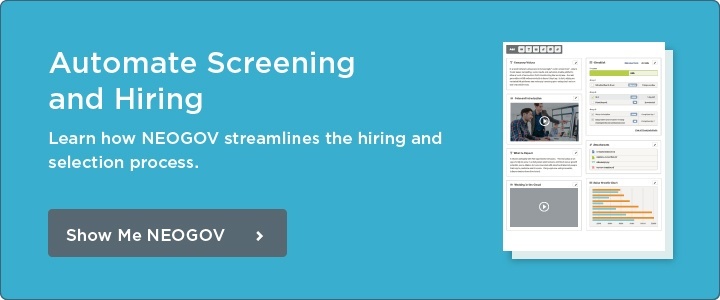An applicant tracking system is more than a human resources tool. The software can reduce frustrations for recruiters, hiring managers, job applicants, and everyone on your staff who pitches in to hire talent.
Executives and human resources leaders are recognizing how applicant tracking software for government agencies can improve the entire employee hiring process. Here are five ways technology can make the HR hiring process less frustrating at your organization.
1. Automates a lot of the early administrative steps in the hiring process
With technology, gone is the job vacancy requisition form that crawls from desk to desk in a tattered interoffice envelope. Instead, human resources can use the software to assign the list of mandatory approvals, then automatically and electronically route the vacancy requisition around the office.
Once the job description is finalized, the software can immediately publish it to your organization’s website. This means human resources won’t have to muck around with website code or wait days for your web team to post the job. The software can also publish the job out to employment websites like governmentjobs.com. Automating administrative tasks like these frees up staff to spend more time on crucial personal, human interactions with applicants.
2. Lets you learn more about job applicants
There’s only so much you can learn about a job applicant from a resume and cover letter. Human resources software provides ways to collect more information about applicants and manage that data so it’s useful instead of overwhelming.
Have applicants use the software to take pre-employment tests online at their convenience, which also minimizes the number of people you have to bring into your office. Include validation questions in your application to identify those who may have exaggerated their skills or falsified their credentials. If there’s a risk people might have someone else take their tests, simply have top candidates retest in person.
3. Improves the applicant’s experience with the hiring process
Technology reduces the stress and frustrations of applying for a job. This helps applicants feel more positive about your organization, increasing the odds they’ll accept your job offer. Applicants can import details from their resume or LinkedIn profile into the system so they don’t have to manually enter their information. Once they’ve added their employment history, education, and skills, they can reuse it to apply for different jobs at your organization or elsewhere.
The software can also make the entire hiring process less confusing and more transparent. Applicants can get updates via email, view their application status, and schedule tests and interviews. Your staff will spend less time writing emails and making phone calls, and will communicate more promptly and effortlessly with applicants.
4. Help staff work as a team to vet candidates
After human resources narrows down the applicants to a small group of the most promising candidates, your staff can use the software to easily send the applications to the hiring manager. The process takes a few clicks and no one will have to print, collate, and keep track of dozens or even hundreds of resumes.
Managing applicant information with software also means human resources can easily involve other employees in vetting job candidates. Your staff can work collaboratively to identify and interview the best candidates with little risk of confusion. Before sending a candidate’s information to other staff, human resources can restrict access to the portions that need to be kept confidential for compliance and data security.
5. Identify and fix bottlenecks in your hiring process
The hiring process is vulnerable to all sorts of delays. An applicant tracking system can provide insights to help your entire organization work smarter, not harder. You’ll be able to identify where there are bottlenecks in the process and why they happen.
Use your applicant tracking software to run reports on a number of valuable data points. Monitor how long the hiring process takes at each step of the process. Look for departments and individuals that might need guidance to streamline the time-consuming but critical process of recruiting the talented people your organization needs to succeed.
